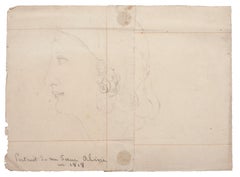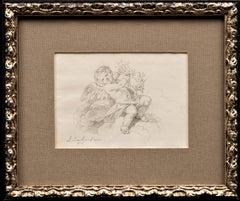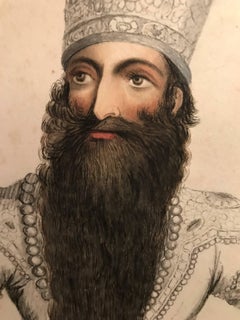1810s Portrait Drawings and Watercolors
to
1
2
Overall Width
to
Overall Height
to
96
634
2,477
840
49
68
111
111
157
174
197
251
188
100
65
1
2
2
2
1
1
1
1
1
2
2
1
1
1
1
1
Period: 1810s
Profile of Woman - Original Pencil Drawing - 1818
Located in Roma, IT
Profile of a Woman is original drawing realized by unknown artist of the early 19th Century.
Dated on the lower 1818 and with description in pencil on the lower left.
Pencil drawin...
Category
Modern 1810s Portrait Drawings and Watercolors
Materials
Paper, Pencil
Drawing of Putti in the Clouds by Jean-Jacques le Barbier l'Ainé (1738-1826)
Located in SANTA FE, NM
Drawing of Putti in the Clouds
Jean-Jacques le Barbier l'Ainé (France, 1738-1826)
Black pencil on paper
Signed and dated lower left "Le Barbier L'ainé 1816"
10 1/4 x 12 1/4 inches ...
Category
Academic 1810s Portrait Drawings and Watercolors
Materials
Paper, Pencil
Related Items
"Self Portrait Conte Sketch" rare Ben Fenske work on paper - academic study
By Ben Fenske
Located in Sag Harbor, NY
A colorful self-portrait from Ben Fenske, staring at the viewer straight-on. Hues of red dominate.
Unframed.
Ben Fenske (b. 1978) although a native of Minnesota, and has been worki...
Category
Academic 1810s Portrait Drawings and Watercolors
Materials
Paper, Conté
$1,200
H 25.5 in W 19 in
"Self Portrait Sketch" Early conte crayon drawing, head of Ben Fenske, unframed
By Ben Fenske
Located in Sag Harbor, NY
An early work on paper, by American Impressionist painter, Ben Fenske. It's rare to see a drawing like this from Fenske, especially of a self portrait. Fenske uses classical draftin...
Category
Academic 1810s Portrait Drawings and Watercolors
Materials
Paper, Conté
French School 19th Century, A Muskeeter, original pencil drawing
Located in Paris, FR
French school 19th Century
A Muskeeter
Pencil on paper
26.5 x 17 cm
Bears a signature "F. Roybet" in the lower right
In quite good condition, bears some visible foxings,
In an old mount (some damages)
(not framed)
Even if the style, execution and of course subject are those of Ferdinand Roybet...
Category
Academic 1810s Portrait Drawings and Watercolors
Materials
Carbon Pencil
Fernand de Launay (1855-1904) Portrait of a child, 1890, original drawing
By Fernand de Launay
Located in Paris, FR
Fernand de Launay (1838-1904)
Portrait of a child, probably the daughter of the artist
Lead pencil on paper
Signed and dated "4 septembre 1890" on the lower left
27 x 21 cm
In quite ...
Category
Academic 1810s Portrait Drawings and Watercolors
Materials
Carbon Pencil
$593
H 10.63 in W 8.27 in
"Contemplation"
Located in Lambertville, NJ
Jim’s of Lambertville is proud to offer this artwork by:
Gershon Benjamin (1899-1985)
An American Modernist of portraits, landscapes, still lives, and the urban scene, Gershon Benj...
Category
Modern 1810s Portrait Drawings and Watercolors
Materials
Graphite
Self Portrait, of the Gentleman himself
Located in New York, NY
A simply marvelous drawing - a self-portrait of the artist himself. It also reads as a very elegant and expressive line drawing of any gentleman - a hallmark depiction of a bon-vi...
Category
American Realist 1810s Portrait Drawings and Watercolors
Materials
Archival Paper, Graphite
Academic Study for the Head of an Apostle or Saint
Located in Firenze, IT
Study for the Head of an Apostle or Saint
Artist: Enrico Reffo (1831-1917)
Medium: Charcoal and white chalk on colored paper
Dimensions: [To be specified]
Date: Late 19th - Early 20...
Category
Academic 1810s Portrait Drawings and Watercolors
Materials
Paper, Charcoal, Carbon Pencil
A Handsome 1940s Portrait of a Seated Man by Chicago Artist, Harold Haydon
Located in Chicago, IL
A Handsome 1940s Portrait of a Seated Man by Chicago Modern Artist, Harold Haydon (Am. 1909-1994). A wonderfully executed line drawing dating from 1946 with great character; looks ...
Category
American Modern 1810s Portrait Drawings and Watercolors
Materials
Paper, Graphite
$135
H 20 in W 16 in D 0.13 in
Portrait Sketch
By Ben Fenske
Located in Sag Harbor, NY
A portrait of a male head, in profile by BenFenske. The artist uses a variety of colors to convey a naturalist impression.
Artist Bio
Ben Fenske (b. 1978) although a native of Minn...
Category
Academic 1810s Portrait Drawings and Watercolors
Materials
Paper, Conté, Crayon
Young man in a toga elegant man Latin American hyperrealist Hockney style
Located in Norwich, GB
Superb original drawing in coloured conté pencils, heightened with white on oatmeal coloured vergé paper by Claudio Bravo. The work was created during the artist's Moroccan period, a...
Category
Modern 1810s Portrait Drawings and Watercolors
Materials
Conté, Laid Paper, Color Pencil
$7,500
H 30.32 in W 24.02 in D 0.4 in
Apelles holding his palette and brushes
Located in Paris, Île-de-France
Jean-Auguste-Dominique Ingres
(Montauban 1780 – Paris 1867)
Apelles holding his palette and brushes
Late reinterpretation after The Apotheosis of Homer – c. 1860
Black chalk, stump...
Category
Academic 1810s Portrait Drawings and Watercolors
Materials
Laid Paper, Pencil
$9,590
H 11.82 in W 7.09 in
Edouard Detaille (1848 1912) Soldiers, a study, ink on wood
Located in Paris, FR
Edouard Detaille (1848-1912)
Soldiers, a study
Black ink on a wood panel
12.5 x 13 cm
Framed : 20 x 20.5 cm
On the back of the panel a label inscribed "Dessin à la plume par Detaill...
Category
Academic 1810s Portrait Drawings and Watercolors
Materials
Ink
Previously Available Items
Portrait of Futteh Ali Shah, Second Qajar Emperor of Iran
By Robert Ker Porter
Located in London, GB
Sir Robert Ker Porter (1777–1842)
Portrait of Futteh Ali Shah, Second Qajar Emperor of Iran
Pencil & watercolour on paper
11 x 8.5 inches (sheet)
Literature;
Joseph M. Upton, The History of Modern Iran: An Interpretation. Harvard University Press. Cambridge M.A, 1960, p.4.
Piggot, John (1874). Persia: Ancient & Modern. London: Henry S. King & Co. p. 89
John H. Waller, Beyond the Khyber Pass: the road to British disaster in the First Afghan War, Random House: London, 1990, p. 59.
This intricate and captivating portrait represents the Shah of Iran, Futteh Ali Shah. According to the Historian Joseph Upton, the Shah is best known amongst Persians for his exceptionally long beard and his wasp like waist, both of which can be seen this portrait. The Shah, seen dripping with jewels and armed with decorative weaponry was a noted sybarite and his ornate crown and beautiful clothing demonstrate his decadent and opulent nature.
Futteh Ali Shah reigned from the 17th of June 1797 until his death in 1834. His reign is generally associated with two disastrous military campaigns against the Russian Empire, both of which ended in the Shah having to sign treaties ceding Persian territories to the Tsar. It is however his personal life about which legends abound and most writers focus on.
Throughout his reign, Futteh Ali Shah did much to reinvigorate the arts in Persia, particularly portrait painting and large oil paintings. This was down in no small part to his personal patronage. The Shah also restored life at court insisting it be more civilised and that more rigid customs were followed.
A noted womaniser, the Shah was said to have had more than 1,000 spouses. A late 19th century English traveller to Persia wrote “"It is believed that Futteh Ali had the largest number of children ever born to a man. Like a pious Mohammedan, he had only four wives, but his harem generally contained from 800 to 1000 ladies. By these he had 130 sons and 150 daughters, and it is believed that at the time of his death his descendants numbered five thousand souls”. The greatest decadence of the Shah’s, as noted by foreign diplomats to Persia, was the construction and use of what is referred to as Naser al-Din Shah's slide. “Every day he would lie on his back naked as, one by one, naked harem beauties swooped down a slide, specially made for the sport, into the arms of their lord and master before being playfully dunked in a pool”.
Sir Robert Ker Porter (1777–1842)
The artist of the work is the Scottish diplomat, author and artist Sir Robert Ker Porter. Ker Porter was a noted traveler of his day and his travel writing was hugely popular to an early 19th century audience. Alongside drawing the Shah’s portrait...
Category
Old Masters 1810s Portrait Drawings and Watercolors
Materials
Watercolor
Recently Viewed
View AllMore Ways To Browse
Playboy Posters Vintage
Poster Corse Vintage
Punk Rock Posters
Remy Hetreau
Richard Bowman
Roger Worms
Roy Lichtenstein Triptych
Saint Croix
Salvador Dali Bust
Salvador Dali Watch
Sandy Hook Painting
Sanford Sculpture
Scott Hill
Shelter Serra Birkin
Shepherd In The Scottish Highlands
Sherrie Mcgraw
Sixties Posters
Smooth Fox Terrier


